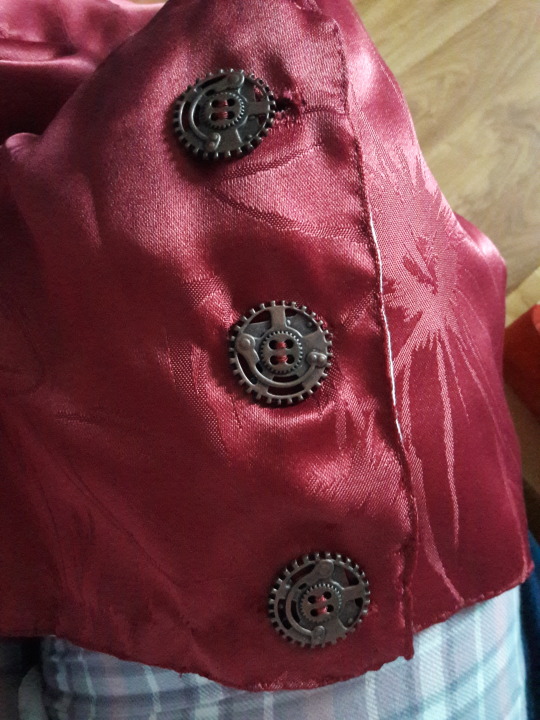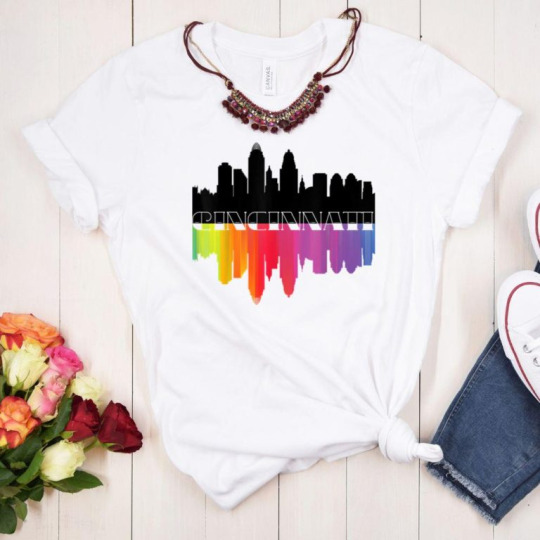#now with zero historical authenticity
Explore tagged Tumblr posts
Text
Amateur sewing - Red Riding Hood
So, uh... I've sewn a thing.

I'm reusing an old curtain here, it's polyester. It looks nice in theory, but I'm not even going to try and pretend it's anything else than 100% plastic. 140 cm x 140 cm square for the cloak, approximately an eternity of hemming.

Behold! Two different sets of lines that don't actually say anything because I can't do math and had to do the pleating, like, a dozen times.

First half of a box pleat in the making, 7 cm wide. I wanted a pretty drape for the back, and we're getting there.

Box pleat in the middle, additional knife pleat on either side. When I realized that the cloak was still too wide to fit into the shoulder capelet the way I wanted it, I cartridge-pleated the outer several centimeters up to the knife pleats.



Speaking of, shoulder capelet! I started out with two 40 cm x 40 cm squares outer fabric and the same size of lining. The lining is the rest of a duvet cover I began slaughtering for lining a while ago, cotton, because I may be cheap but I'm not suicidal. Don't want that much polyester directly on my skin. I sewed the squares together and hemmed them all around except for the corners where I still had to figure out how much I needed for my neck, and that got me to the yoke shape you can see above.



Could I have gotten away with a more practical closure than buttons? Yeah, definitely. Especially since this "fabric" frays like a bitch. I can actually do a darling buttonhole stitch, but you wouldn't be able to tell from this because I was working against the fabric. Then again, I had these buttons lying for around for far too long; they were presents from a friend and I never got a use for them. A fantasy-ish Red Riding Hood cape with zero historical basis seemed like the way to go, and I love them.



The finished capelet was kinda uselessly bunching around the neck, but I didn't much bother with that because there's still a hood waiting to go there. The way it fell over the arms when I didn't spread them was a bit more annoying, so I took in a tiny lil dart on each side, back and front.



I wanted a huge-ass hood for this. In the end, it would have probably been wiser to use the bigger squares for the shoulder capelet, but I have no regrets. Same story as with the capelet, just a lot less complicated; off with the corner and in with the lining.


That's how the whole mess looks on the inside of the capelet, the back of the hood cartridge-pleated down until it fit the neck opening. It's not pretty, but I really fastened every tuck twice and thrice. Then the cloak... oh boy, that nearly broke me. But I sewed it in around the back half of the neck opening so that it came out in the centers of my shoulders, and from there in a 90 degree-angle down the back. It ran out in that L shape you can see up there, not so much because I intended it but because I didn't have the best control over the cartridge-pleated outer part of the cloak.



And after I sent around the poll... I just went and did the opposite of its result ^^' I did end up putting the fancy golden trim around the capelet instead of the hood bc 1st, people I asked live said it'd look better there, and 2nd @kittycatalex made a pretty good point for sensory issues. And it looks so nice. Look at this big hood. I can play such a shady figure in this. The whole cloak is a bit top-heavy because the hood is bigger than the capelet, and the cloak doesn't have any lining, but that only means that the back can dramatically go whoooosh when I move. And when I don't move - behold that drape! So worth the bother!
8 notes
·
View notes
Text
I’m a little disappointed to see so much discourse, fandom competitiveness, and plain arguing going around at the moment in regards to queer film/TV. People complaining about too much sex, not enough sex, too cheesy, made for the hets, too happy, too sad, too realistic, too unrealistic, and a million other petty issues. I, for one, am a queer person in my 50s and I grew up with practically zero representation! Yes, we want to continue onwards and upwards with quality and varied shows BUT let’s be HAPPY we now have representation! Like, actual shows where the central characters are queer, not just a side character who gets f*cking murdered! There is room for all different types of representation - so enjoy the types you like, and let others enjoy what they like.
And on a side note: progress is progress and film/tv is a business that has to turn a profit! If some queer content is made to appeal to the straight community, and will also act as a means of reducing homophobia and increasing understanding, then that’s a good thing. That means in the future more and more content will include queer stories and representation. If only 10% (ish) of the population is the maximum target audience then shows won’t keep getting made!
There is a huge backlash all over the world right now - a “push back” by conservatives and religious groups that want to wind back the clock, and specifically the last decade of advances.
So stick together queers and LGBTQIA+ allies.
I’m super happy knowing I don’t have to wait years between content anymore. And I’ve loved all different types of shows over the last 5 years, for lots of different reasons!
Interview with the Vampire - is giving me the toxic, passionate gothic love affair I’ve always wanted. And addressing interracial relationships.
Heartstopper - is filling me up with pure joy and hopefulness for the future.
Shameless - gave me Ian and Mickey - unique, anti stereotypical gays with a tragic yet ultimately beautiful love story spanning 11 years
Lone Star 911 - is giving me TK and Carlos whose sexuality barely factors into the storyline! Yay!
Looking - gave me an authentic queer experience and an intoxicating love triangle.
Red, white and Royal Blue - gave me a sweet, cute romcom that allowed reality to be sidelined. Fun escapism!
Young Royals - had me captivated by first love and intense angst.
Fire Island - an underrated romcom that made me laugh so hard I cried.
Sex education - shoved the realities of sex in our faces and provided me with laughter and drama and a range of queer identities.
Gentlemen Jack -gave me historical lesbians with spectacular wit, and feminine power.
And that’s just the tip of the iceberg- because there’s SO SO SO many more shows I could mention! Don’t at me because I didn’t mention YOUR favourite. This is my point! There is SO much great content it would take all day for me to include everything. This is just a sample - and that’s f*cking brilliant!!
So maybe we could all start posting/tweeting etc about what WE DO LIKE / LOVE / MAKES US FEEL LOVED AND SEEN and put down the device if we’ve got nothing nice to say.
Sending everyone a love filled week! 💜

#interview with the vampire#amc iwtv#heartstopper#rwrb#red white and royal blue#nick and charlie#ian and mickey#shameless#louis and lestat#alex and henry#911 lone star#tk x carlos#queer as folk#sex ed netflix#fire island#bros#loveislove#queer love#ofmd#the l word#young royals#elite netflix#wilhelm and simon
908 notes
·
View notes
Note
can you elaborate more on the joyful/optimistic art vs cynical/sad art thing?
(re: this post)
sure, sorry in advance if this is messy.
the gist is that there's a slew of micro-discourses whose common thread is the inherent or automatic superiority of art and stories that are optimistic and centre 'joy', 'love', and other positive emotions over those that don't.
it manifests a million different ways: "x series is bad because it's pessimistic/cynical/dark", "x story is bad because it depicts SA/incest/abuse*", "horror is really about love/family", "love is a unilaterally healing and moral force", "dark/negative art is universally less authentic/earnest", "sad/disturbing art is easy to make while positive art is difficult," etc. (also seems to correlate w the internet's general attitude toward criticism--that even mild negative feedback toward any art is in essence insulting its author & audience)
one of the factors imo is that a lot of people are unwilling to interrogate their reactions to something. like the process is "i see disturbing art -> i feel disturbed -> 'disturbed' is a negative emotion -> this art has done something negative to me -> this art is bad" and then never question it further
as for why i feel frustrated: hmm where to start. it's an extremely flat heuristic that diminishes alll art with any aims other than to please or to be Fun. it denies that "to disturb", "to frighten", "to disquiet", "to sadden", "to critique", etc are worthwhile endeavours in art. it also just betrays a narrow view of what has the capacity to be Fun for someone! i'm especially frustrated because horror always gets the brunt of it. there's a sort of longstanding anxiety about the "value" of horror, about horror needing to "prove its worth", and i think a lot of people's answer to that is to say "it's not actually about Scary, it's about Happy :)"
one of the really popular takes that i still see today is "if you're writing a fantasy story where anything can happen, why incorporate homophobia, misogyny, etc?" and, i mean, it's a pretty straightforward answer--because those things exist in real life, and by incorporating them into a story you can reflect, comment on, and explore real issues that are pertinent to the audience! likewise re "love is virtuous and healing," it's just a simple fact that love is morally neutral. people do HORRIBLE things for love all the time. i used to be more idealistic about this, but now i honestly cant stand the idea that a saccharine, childlike stance on love is by default a better one
(there's a huge comparison to be made here with the reactionary pushback against modern art btw)
it also ties into a broader schema--"toxic positivity" is a popular line, but we can aim higher: there's a sort of cultural mandate toward positivity, where saying "x is bad" is worse than x being bad. think right and send thoughts and prayers. capitalism loves the idea of each person fending for themselves--you have the whole concept of "wellness" and "mindfulness", ie Positive Thinking as a vector for mental health (the corollary being that a person who is unwell is a person who is Not Trying Hard Enough To Be Positive), whereby to read a situation cynically (or pragmatically!) is the worst thing you can do. and well, by the same token, when we have a whole cavalcade of employers who LOVE seminars and videos about How To Manage Your Stress (and zero interest in inspecting what it is that makes employees excessively stressed to begin with!), im sure you can imagine why someone could get exhausted of positivity.
as i said in the previous post, the most insane part is the particular framing of this atittude as somehow counterculture, controversial, or against the grain. y'know, when we're discussing chipper upbeat art about how everything is good vs art that's grim, violent, negative, pessimistic--which of these is most likely, historically and today, to be censored, to be banned, or to arouse controversy?
*(obviously there are depictions of SA and other sensitive subjects that are callous, sexist, etc! but there are also plenty that are trenchant, edifying, powerful, evocative, etc!)
3 notes
·
View notes
Text

And now Terry Eagleton weighs in on Amis with the obituary as hatchet job, letting slip with remarkable explicitness, almost coarseness, what radicals sometimes prefer to cloak under "smash the fash" moralism: that, all things being equal, they prefer a reactionary or a fascist to a liberal, and for two reasons: first, they think liberals are secret fascists anyway, at least after being mugged, and so an avowed fascist is more honest; and, second, they credit reactionaries and fascists with worldviews as articulated and englobalizing as the radicals' own, whereas the liberal is merely a naive empiricist without a thought in his head, more literally reactionary than the reactionary (who has at least read Aquinas or Heidegger or somebody and has therefore thought everything through) because all he can do is react. Therefore, say Eagleton, ultra-right-wing literary modernists are to be preferred to their liberal literary heirs.
What saves Eagleton here is how very well this applies to the particular cohort he's discussing, typified by the "'no bullshit' bullshit" (in Stefan Collini's words) Hitchens ended up adopting from Orwell. There is a streak in the Anglo character—and the Anglo-by-adoption character, as witness Rushdie—of a bluff and constitutionally anti-intellectual empiricism that strands the English novelist, when he turns pundit, in the very clichés he wished to war against. Already in the 19th century Mill and Arnold tried to wed English liberalism to Continental idealism precisely to relieve this intellectual enervation. To that extent, Eagleton's Marxist (and Catholic and Irish) critique may be defended.
It should also, however, be answered with counter-evidence. I don't mean to startle some of my younger and more enthusiastic followers, but we have historical reasons to be wary of actively pursuing a situation where radical fights reactionary in a zero-sum contest as the bottom drops out of society. Leaving that aside, literary liberalism, in the broadest sense, also encompasses fuller visions than Eagleton credits, even among the modernists, such as the mysticisms of Woolf and Forster. The politics to which he reduces Conrad, Lawrence, Yeats, and Eliot do not exhaust the whole of their sensibilities, either. As for American literature, which Amis revered, Eagleton's critique applies not at all—even the broad-minded Mill thought Emerson a madman. And why not mention the highest high modernist of them all?—I mean Joyce.
It's true that translating the dense and almost second-sighted perceptiveness Amis worshipped in Bellow and Nabokov into a political program can go wrong in all sorts of ways since it has no syllogistic hedge against ethical error—but then it's not like the far left never slaughtered anybody either, a point underlined by Hitchens's conviction that in supporting the Iraq War he'd kept faith with the tradition of Marxist revolution. The moral high ground Eagleton thinks he's standing on doesn't exist.
At its best, Amis's literary aestheticism is an ethic, is even an authentic spiritual practice, a higher way of seeing, if one perilous to translate directly into an elaborated ethical, still less a political, system. Eagleton identifies real 20th-century problems, but only offers long-played-out 20th-century solutions.
6 notes
·
View notes
Text

Table of Contents - Micro-Segmentation for Precise Targeting - User-Generated Content to Boost Credibility - Integrating AI for Smarter Insights - Optimizing for Mobile Users - Personalized Experiences - Engaging with Interactive Content - Prioritizing Data Privacy - Embracing Minimalist Design - Channel Synergy Email has grown into a staple of digital communication, establishing itself as a high-impact marketing tool. Its efficiency and reach make it ideal for any business looking to connect directly with its audience. Yet, as technology and consumer expectations continue to evolve, keeping up with the latest trends is crucial. Here are the top nine email marketing strategies for 2025 to ensure your messages resonate with your audience. 1. Micro-Segmentation for Precise Targeting Gone are the days of one-size-fits-all email blasts. In 2025, micro-segmentation allows you to zero in on precise customer subgroups, creating highly relevant emails for niche segments. By tapping into more advanced data, marketers can refine audience segments based on unique details like: - Usage Patterns: Screen time, browsing habits, and device types - Purchasing Behavior: Past purchases, frequency, and spending thresholds - Demographics: Age, location, and other key identifiers - Historical Interactions: Engagement history and previous brand interactions This depth of personalization has proven to dramatically increase open rates and drive more conversions, allowing brands to optimize communications based on actual customer behavior. 2. User-Generated Content to Boost Credibility User-generated content (UGC) remains a vital part of authentic digital marketing. From reviews to social media shout-outs, UGC enhances your brand’s credibility by leveraging customers’ voices. Use these strategies to incorporate UGC into your email campaigns: - Highlight Testimonials: Include snippets of positive customer reviews in your emails. - Showcase Social Shares: Feature photos and videos of customers using your products. - Run Contests: Encourage customers to share their experiences via photo contests or comment threads. UGC not only builds trust but also increases engagement, as customers are more likely to respond to content that feels genuine and community-driven. 3. Integrating AI for Smarter Insights With a growing emphasis on data-backed marketing, artificial intelligence (AI) is now a game-changer for email campaigns. AI helps manage, interpret, and implement data for better personalization and efficiency. It supports several key areas, including: - Optimized Subject Lines: AI-driven testing can enhance subject line effectiveness. - Timing Adjustments: Use AI to determine when your audience is most likely to open emails. - Content Recommendations: Personalize email content based on past customer preferences. - List Management: AI can clean and update your mailing lists automatically. As data grows more complex, AI simplifies it, improving campaign performance and ROI. Companies that embrace AI in their marketing are seeing noticeable increases in revenue and customer retention. 4. Optimizing for Mobile Users Mobile email access has surged, with around 85% of users now checking email on smartphones. With so many emails opened on mobile devices, mobile optimization is a non-negotiable. However, studies show that 75% of users delete emails that fail to display properly on mobile. In 2025, responsive design isn’t just a bonus—it’s essential to maintaining your audience’s interest and maximizing engagement. 5. Personalized Experiences Modern consumers want brands to know them well enough to make recommendations and remember their preferences. With data-driven insights, brands can create a personalized experience by: - Using Customer Names: Make emails more engaging with personalized greetings. - Offering Tailored Recommendations: Leverage data to suggest relevant products or services. - Celebrating Special Dates: Acknowledge birthdays or anniversaries with exclusive offers. - Providing Tips and Tricks: Share relevant content, like how-to guides or trending products. The majority of consumers value personalization, with over 80% reporting that a tailored experience makes them more likely to purchase. Investing in personalization strategies fosters a stronger connection with your audience and encourages brand loyalty. 6. Engaging with Interactive Content Interactive content turns passive readers into engaged participants. By adding elements that encourage recipients to act, you make your emails more dynamic and memorable. Interactive features might include: - Surveys and Polls: Ask for feedback to increase customer engagement. - Embedded Videos and Animations: Provide product demos or brand highlights. - Image Galleries: Showcase collections with carousel-style image displays. - Quizzes and Games: Create a fun experience that reflects your brand's personality. Over 92% of buyers find interactive content more engaging, and this trend will likely continue in 2025. Creating an engaging, immersive experience can boost your brand’s appeal and keep customers coming back. 7. Prioritizing Data Privacy Data privacy remains a pressing concern for consumers. In an era of stricter data regulations, brands are expected to be transparent about how they collect, use, and protect customer data. To build trust, consider adding a data privacy message in your emails that explains: - Compliance with Current Laws: Reassure customers that your practices meet legal standards. - Data Collection Policies: Briefly outline what information is collected and why. - Storage and Security Measures: Explain how data is securely stored and protected. - Options for Data Use: Allow customers to control what data is collected and stored. A clear commitment to data protection helps build confidence, ensuring customers feel secure while engaging with your brand. 8. Embracing Minimalist Design In a cluttered digital landscape, simplicity stands out. Minimalist email designs reduce distractions, making the message clearer and more accessible. HTML-styled emails with limited images, whitespace, and concise text can improve readability and lead to better user engagement. Ask yourself: does each visual add value? If not, consider paring it down to essentials, allowing the main message to take center stage. By emphasizing clear, focused designs, your emails can cut through the noise and hold your readers’ attention. 9. Channel Synergy Today’s consumers interact across multiple devices and channels. To maximize engagement, incorporate omnichannel strategies that connect email with other platforms. For example, you might include links to your social media profiles, text message notifications, or a QR code linking to a special offer on your website. Blending email with SMS, social media, and digital ads reinforces your message and boosts the chances of customer interaction. With an omnichannel approach, you create a seamless brand experience that follows the customer journey across multiple touchpoints. Empower Your Email Marketing with PumpTools Email marketing is continually evolving, and 2025 is a prime opportunity to refresh your approach. These nine trends can help you connect with your audience more effectively, transforming routine emails into powerful marketing tools. Ready to implement these strategies? At PumpTools, we specialize in cutting-edge CRM, automation, and digital marketing solutions to support your brand's unique needs. Together, we’ll build an email marketing strategy that captures attention, deepens customer relationships, and drives growth. Read the full article
0 notes
Text
Price: [price_with_discount] (as of [price_update_date] - Details) [ad_1] Elevate your mocktail game with the SOBER Non-Alcoholic Spirits Combo, featuring three premium zero-alcohol spirits: Gin, Rum, and Whiskey. Designed for those who enjoy the rich, bold flavors of traditional spirits without the alcohol content, this collection is perfect for crafting sophisticated mocktails and alcohol-free cocktails. Whether you're hosting a party or unwinding after a long day, SOBER offers a refreshing, flavorful experience that everyone can enjoy. Each bottle is crafted with natural botanicals and authentic flavors to create the perfect balance of taste, ensuring your mocktails taste just as good as their alcoholic counterparts. Enjoy the versatility of this trio in everything from a refreshing gin and tonic, a classic rum punch, or a smooth whiskey sour—now, without the alcohol. WHY NON-ALCOHOLIC? Because experiments are fun, especially when you’re making a Gin alternative for people who can’t consume alcohol on some days or ever for varied reasons.They could be grave health reasons or personal resolutions to shed some calories. We also believe celebrations ought to be inclusive of the calm and collected. Now everyone has a choice! WHAT DOES IT TASTE LIKE? Our herbaceous Gin Alternative has an earthy taste profile thanks to all the goodness of herbs with predominant Juniper notes wonderfully adding an authentic flavour to the mix. HOW DO I CONSUME IT? Pour it just like your traditional gin in your favorite recipes, or mix with tonic water or soda or juice. You can even have it straight on the rocks, we’re not judging. WHAT’S THE PROCESS? We extract sophisticated flavors from all-natural sources at our workshop in South Goa. Some herbs and botanicals we use are associated with therapeutic properties. We distill that historical knowledge into bottles of happiness to lock it in, that’s where the flavour profile and health benefits come from. Juniper berries, Tulsi and Ashwagandha are the three key ingredients we use to make Sober spirits for better days. [ad_2]
0 notes
Text
Global DDoS Protection And Mitigation Security Market Analysis 2024: Size Forecast and Growth Prospects
The ddos protection and mitigation security global market report 2024 from The Business Research Company provides comprehensive market statistics, including global market size, regional shares, competitor market share, detailed segments, trends, and opportunities. This report offers an in-depth analysis of current and future industry scenarios, delivering a complete perspective for thriving in the industrial automation software market.
DDoS Protection And Mitigation Security Market, 2024 report by The Business Research Company offers comprehensive insights into the current state of the market and highlights future growth opportunities.
Market Size - The DDoS protection and mitigation security market size has grown rapidly in recent years. It will grow from $4.32 billion in 2023 to $4.36 billion in 2024 at a compound annual growth rate (CAGR) of 15.3%. The growth in the historic period can be attributed to increasing frequency and complexity of DDoS attacks, rising cybersecurity concerns, dependency on internet-based services, financial loss prevention, and global expansion of online services.
The DDoS protection and mitigation security market size is expected to see rapid growth in the next few years. It will grow to $8.70 billion in 2028 at a compound annual growth rate (CAGR) of 14.7%. The growth in the forecast period can be attributed to IoT-related threats, edge computing and cloud services, rise in ransom DDoS attacks (RDDoS), and zero-day attack preparedness. Major trends in the forecast period include AI and machine learning advancements, increased focus on zero-trust architectures, behavioral biometrics for user authentication, 5g network preparedness, and quantum-safe cryptography.
Order your report now for swift delivery @ https://www.thebusinessresearchcompany.com/report/ddos-protection-and-mitigation-security-global-market-report
Scope Of DDoS Protection And Mitigation Security Market The Business Research Company's reports encompass a wide range of information, including:
1. Market Size (Historic and Forecast): Analysis of the market's historical performance and projections for future growth.
2. Drivers: Examination of the key factors propelling market growth.
3. Trends: Identification of emerging trends and patterns shaping the market landscape.
4. Key Segments: Breakdown of the market into its primary segments and their respective performance.
5. Focus Regions and Geographies: Insight into the most critical regions and geographical areas influencing the market.
6. Macro Economic Factors: Assessment of broader economic elements impacting the market.
DDoS Protection And Mitigation Security Market Overview
Market Drivers - The rising adoption of IoT devices is expected to propel the growth of the DDoS protection and mitigation security market going forward. IoT, or the Internet of Things, refers to a network of interconnected devices embedded with sensors, software, and other technologies that enable them to collect and exchange data over the Internet without human intervention. IoT devices with sensors and network monitoring capabilities can analyze traffic patterns in real-time. By continuously monitoring incoming and outgoing traffic, these devices can detect anomalies and suspicious activities indicative of a DDoS attack, such as a sudden surge in traffic volume or unusual patterns of packet transmission. For instance, in August 2022, according to Akamai Technologies Inc., a US-based internet company, IoT connections are expected to increase from 15.1 billion in 2021 to 23.3 billion IoT connections in 2025. Therefore, the rising adoption of IoT devices drives the growth of the DDoS protection and mitigation security market.
Market Trends - Major companies operating in the DDoS protection and mitigation security market focus on integrating AI and ML, such as ML-based adaptive DDoS protection, to meet the growing demand for security. ML-based adaptive DDoS employs machine learning algorithms to identify and stop dynamic DDoS attacks quickly. For instance, in July 2023, NetScout Systems Inc., a US-based networking company, launched ML-based adaptive DDoS protection for Arbor Edge Defense (AED). This solution is a scalable and efficient stateless packet processing solution for businesses dealing with the ongoing threat of DDoS attacks because it is based on decades of DDoS mitigation experience and offers unparalleled real-time visibility into global DDoS attack activity.
The DDoS protection and mitigation security market covered in this report is segmented –
1) By Component: Hardware Solution, Software Solution, Services 2) By Application: Network Security, Endpoint Security, Application Security, Database Security 3) By Vertical: Government And Defense Banking, Financial Services And Insurance (BFSI), Manufacturing, Energy And Utility, IT And Telecommunication, Healthcare Education, Retail, Other Verticals
Get an inside scoop of the ddos protection and mitigation security market, Request now for Sample Report @ https://www.thebusinessresearchcompany.com/sample.aspx?id=14084&type=smp
Regional Insights - North America was the largest region in the DDoS protection and mitigation security market in 2023. The regions covered in the DDoS protection and mitigation security market report are Asia-Pacific, Western Europe, Eastern Europe, North America, South America, Middle East, Africa.
Key Companies - Major companies operating in the DDOS protection and mitigation security market are Microsoft Corporation, Huawei Technologies Co. Ltd., Amazon Web Services Inc., BT Group plc, Fortinet Inc., Akamai Technologies Inc., F5 Networks Inc., VeriSign Inc., Cloudflare Inc., NetScout Systems Inc., Imperva Inc., Fastly Inc., Radware Ltd., A10 Networks Inc., Comodo Security Solutions Inc., Allot Ltd., StackPath LLC, HaltDos Pvt. Ltd., SiteLock LLC, Seceon Inc., Sucuri Inc., PhoenixNAP LLC, Corero Network Security Inc., Indusface Pvt. Ltd., Link11 GmbH, Mlytics Inc., RioRey Inc., DDoS-Guard Corp., StrataCore Inc., Active Reach Ltd.
Table of Contents 1. Executive Summary 2. DDoS Protection And Mitigation Security Market Report Structure 3. DDoS Protection And Mitigation Security Market Trends And Strategies 4. DDoS Protection And Mitigation Security Market – Macro Economic Scenario 5. DDoS Protection And Mitigation Security Market Size And Growth ….. 27. DDoS Protection And Mitigation Security Market Competitor Landscape And Company Profiles 28. Key Mergers And Acquisitions 29. Future Outlook and Potential Analysis 30. Appendix
Contact Us: The Business Research Company Europe: +44 207 1930 708 Asia: +91 88972 63534 Americas: +1 315 623 0293 Email: [email protected]
Follow Us On: LinkedIn: https://in.linkedin.com/company/the-business-research-company Twitter: https://twitter.com/tbrc_info Facebook: https://www.facebook.com/TheBusinessResearchCompany YouTube: https://www.youtube.com/channel/UC24_fI0rV8cR5DxlCpgmyFQ Blog: https://blog.tbrc.info/ Healthcare Blog: https://healthcareresearchreports.com/ Global Market Model: https://www.thebusinessresearchcompany.com/global-market-model
0 notes
Text
10 Best Ways to Plan a Small Group Trip with Women

With the pandemic and the declining world over, many countries are opening up their doors to tourists. Travelling to new climes is a much-needed proposition to most people right now as they clamour to get the vacation of their dreams after the lockdown imposition.
That being said, another thing that has become very popular is women-only travel groups. Women have finally broken the bias of not being able to, cannot or should not travel solo. Finally, over the last decade or so, women are gathering experiences worldwide, travelling with travel groups that focus solely on “Women only trips

Travel has always been a form of reconnecting with the self. For most women, travelling in group trips for women
or solo has been a way to rediscover themselves and learn new things along the way, which may not have been possible under different circumstances. And that too, in a safer setting and space.

We have selected the 10 best ways to travel for women and without further ado, let’s get to it because we believe that planning a trip is not rocket science and there are several well-managed women’s solo travel groups that can take you on your fun vacay!
What is the real reason to travel? At times, some of us know where we want to travel and some of us need to get inspired. What could it be? Is it that you haven’t travelled in a long while? Or do you want to experience certain weather (could be winter snow or spring or autumn) in said place? Or have you heard so much about the culture of a place that you want to experience it firsthand? Could it be that you want to get lost in the historic monuments of an old city? Zero in on this first before you embark on your expedition.
Research the destination. Sketch your itinerary. There are plenty of travel blogs and tourism sites for authentic information. The Lonely Planet is the best way to go, but please use your discretion and go wild with this particular research because, in this matter, more is more & more. Make a list of realistic places to see and also add a few unrealistic ones (which can be out of time, distance or budget) because never say never, it can magically be squeezed in if you find a like-minded fellow traveller who would not hit the snooze button and explore that one market around the corner with you. Make a list of activities you would want to do and be creative. Jot everything down and don’t forget to look up Trip Advisor.
A must-have is a must-do. Some places and activities are non-negotiable. Imagine going to Paris and not going up to the Eiffel Tower. Duh! But besides that, research will help you find your ideal must-do, which could be like the Lindt factory in Switzerland or kaftan shopping in Morocco and closer home, plucking apples in an orchard in Tirthan, or river-rafting in the mighty Brahmaputra in Arunachal Pradesh. One thing to remember and acknowledge is that you don’t have to go to a certain monument if it is of no interest or importance to you, this is your holiday so do what makes you happy and not because all the tourists are headed there.
Pack appropriately. While this one seems like a no-brainer, believe me, putting some thought into packing can be rewarding. Make sure you have all the essentials in smaller packages, which in turn will make space for things that you may buy on impulse. Roll your clothes and use space appropriately for the things you know you will buy for certain. For example, roll your socks and stuff them into your shoes, little trinkets if absolutely necessary can find a corner in there too. And try to carry no more than two pairs of shoes and one pair of a slip-on. Also, this evidently depends on the destination. What if you need hiking boots? You may reach out for that extra pair of jeans but avoid it. Always remember on group trips for women, less is more. This is a holiday and you don’t have to dress to impress.
Plan your budget. Although in a “Best solo trips for women” situation, you are paying the company that is managing the holiday, a flat rate which may account for travel tickets, stay and sightseeing according to their itinerary. But to have your own small unique experiences, you may need to spend some more. Let’s say you skip the excursion to the museum for an extra hour of meditation at the monastery in Ladakh, for example. And now that you have some time to kill, maybe a visit to the local Tibetan market?!? Well, are you stopping at window shopping itself? Hmm, so isn’t it better to know how much you are going to spend on shopping during a holiday so as to not overstretch your pocket? Or eating at the local places that may or may not be in your travel company’s plan? Hence, we come back to point number 2, research! This will give you major insights.

Book tickets: I mean…… if you are not travelling with a company that organises the Best solo trips for women with utmost care and experience, you need to do all the bookings. Flight tickets, and to and fro from the hotel and airport. Besides, a lot of tourist attractions internationally are ticketed and the best bet is to book it way in advance due to the influx of tourists. Why take a chance? Also, it is always good to understand the local travel system in a city. For example, it’s good to have a basic knowledge of the tube in London, or else you will end up paying through your nose for the beautiful, vintage black cabs there.
Book your accommodation. As a group of women, it is imperative to look for a safe, clean and tourist-viable place. By that I mean, find a place that is best suited to your travel needs. While one can get to the destination and find a reasonable and convenient place to stay too, it is always better to be prepared than to be sorry. For example, visiting Edinburgh, Scotland in August, any given year, without prior bookings could land you in a big soup as people from all over the planet travel there in this month to prepare for the big literary, arts, theatre, history and music festival there is, “The Fringe Festival ”. Even sleeping in the alleyway was not an option at the time, due to the crowd and weather, and anyway, every inch of the square yardage of land is taken over by artists from all over the world. Whether it’s a hostel, a boutique hotel, a luxury hotel or an Airbnb, you should book first.

Go ahead and book activities as well. Once you have it down pat as to what all touristy places you would like to visit, it is always good to check them out at their website as well as the Tourism board. There are many discounts to be availed of and you may miss the bus on that if you wait right up to the last day (or not). Booking everything in advance saves you money and time. And a great way to save money and get a regulated tour is to get a city pass so that you can hop on and off the city tour bus at your pace and still have not missed a thing! Check this out at the tourism board website. Lastly, also make sure that if you are booking a popular site’s ticket, you definitely have a spot on the stipulated date and time.
A small First-Aid box to the rescue. The farthest thing from our mind, when we plan a trip, is a mishap or unwarranted illness. But more often than not, people do fall ill albeit mildly due to different reasons. Could be the weather change, the time difference if travelling internationally or the cuisine. Or just the plain bug. It is important to carry all the basic medications and a first-aid box due to such emergencies. Can you imagine yourself in a place where you don’t know the local dialect and trying to find the nearest pharmacy when you have a raging headache? Better still, take your vitamins regularly and study a lot about the weather conditions and be prepared.
Cold, hard cash counts. While there are ATMs across the planet, it is always advisable to carry some amount of cash on your person. There can be small, tucked-away corners that don’t have the facility in a workable condition or some other unforeseen circumstance. Roll up the cash, divide into three to four different wads and hide it in different places because, in case of a pickpocket, you are stranded. This way ensures you have money at any cost. In the case of foreign currency too, it is advisable to convert your money and carry traveller’s cheques as well.

When planning a women’s travel solo group in India or abroad, whether it may be a wellness trip or a touristy one, an experiential getaway or an adventurous sojourn, all the above tips come into play. Ask yourself these questions:
Am I looking for a cultural experience?
Does adventure travel float my boat?
Do I need to get away in time and visit some historical places?
Will trying out new cuisines be my calling for this vacation?
Do I just need a break from the routine normalcy this life has become?
The answers to these questions will send you pandering off in the right direction. And if you do not like to do all the planning, leave it up to us. We will ask you the pertinent questions, suggest a destination and create your travel itinerary, while you can just sit back and relax. Visit our website to see all places you can visit now!
#Women's Travel Groups#Adventure Tours for Women#Women only trips#women-only travel groups#group trips for women#women's solo travel groups
0 notes
Text
Passwordless Authentication Market 2024 : Size, Growth Rate, Business Module, Product Scope, Regional Analysis And Expansions 2033
The passwordless authentication global market report 2024from The Business Research Company provides comprehensive market statistics, including global market size, regional shares, competitor market share, detailed segments, trends, and opportunities. This report offers an in-depth analysis of current and future industry scenarios, delivering a complete perspective for thriving in the industrial automation software market.
Passwordless Authentication Market, 2024 report by The Business Research Company offers comprehensive insights into the current state of the market and highlights future growth opportunities.

Market Size - The passwordless authentication market size has grown rapidly in recent years. It will grow from $17.13 billion in 2023 to $20.07 billion in 2024 at a compound annual growth rate (CAGR) of 17.2%. The growth in the historic period can be attributed to increased cybersecurity threats and data breaches, proliferation of mobile devices, regulatory compliance requirements, increased adoption of cloud computing, and incresed awareness of password management best practices.
The passwordless authentication market size is expected to see rapid growth in the next few years. It will grow to $38.30 billion in 2028 at a compound annual growth rate (CAGR) of 17.5%. The growth in the forecast period can be attributed to heightened focus on user experience and convenience, shift towards zero-trust security architectures, rising demand for stronger authentication methods, growing integration of passwordless authentication, and increasing regulatory emphasis on data protection. Major trends in the forecast period include multi-factor authentication (MFA) solutions, behavioral biometrics, continuous authentication technologies, and innovative solutions.
Order your report now for swift delivery @https://www.thebusinessresearchcompany.com/report/passwordless-authentication-global-market-report
The Business Research Company's reports encompass a wide range of information, including:
1. Market Size (Historic and Forecast): Analysis of the market's historical performance and projections for future growth.
2. Drivers: Examination of the key factors propelling market growth.
3. Trends: Identification of emerging trends and patterns shaping the market landscape.
4. Key Segments: Breakdown of the market into its primary segments and their respective performance.
5. Focus Regions and Geographies: Insight into the most critical regions and geographical areas influencing the market.
6. Macro Economic Factors: Assessment of broader economic elements impacting the market.
Market Drivers -The growing concerns about data security are expected to propel the growth of the passwordless authentication market going forward. Data security refers to the process of protecting digital information at every stage of its lifecycle to prevent corruption, theft, or unauthorized access. There is growing concern for data security due to several factors, including heightened connectivity, the growing complexity of IT systems, and sophisticated hacking techniques. Passwordless authentication strengthens data security by replacing traditional password-based methods with more secure factors, including biometrics, hardware tokens, or cryptographic keys, thereby enhancing authentication and minimizing the risk of unauthorized access to sensitive data. For instance, in March 2024, according to the Federal Bureau of Investigation (FBI), a US-based law enforcement agency, there were 880,418 cybercrime complaints received by the FBI from the public in 2023, marking a 10% rise from the previous year's figure. Furthermore, in January 2023, according to Check Point Software Technologies Ltd., an Israel-based provider of cyber security solutions, global cyberattacks saw a 38% increase in 2022 compared to 2021. Therefore, growing concerns about data security are driving the growth of the passwordless authentication market.
Market Trends - Major companies operating in the passwordless authentication market are providing innovative solutions, such as secret location authentication services, to maximize their profits in the market. Secret location authentication services refer to a method of passwordless authentication that relies on a user's physical location as a means of verifying their identity. For instance, in April 2024, Center Identity, a US-based cybersecurity company, launched its Patented Secret Location Authentication, a method where users authenticate via a chosen map location, eliminating complex passwords. Instead of requiring traditional passwords or authentication tokens, secret location authentication uses geolocation data to confirm that the user is in a specific, predetermined location. Additionally, it leverages artificial intelligence, ensuring that hints for selected secret locations meet robust cybersecurity standards and offering users an easy recovery mechanism. This cost-effective method requires no additional devices, unlike hardware-dependent solutions. This will help Center Identity optimize productivity while safeguarding businesses with stringent security measures and simplified access management.
The passwordless authentication market covered in this report is segmented –
1) By Type: Fingerprint Authentication, Palm Recognition, Iris Recognition, Face Recognition, Voice Recognition, Smart Card 2) By Component: Hardware, Software, Services 3) By Authentication Type: Single-factor Authentication, Multi-factor Authentication 4) By Portability: Fixed, Mobile 5) By End-user: IT And Telecom, Retail, Transportation And Logistics, Aerospace And Defense, BFSI, Healthcare, Government
Get an inside scoop of the passwordless authentication market, Request now for Sample Report @https://www.thebusinessresearchcompany.com/sample.aspx?id=15436&type=smp Regional Insights - North America was the largest region in the passwordless authentication market in 2023. Asia-Pacific is expected to be the fastest-growing region in the forecast period. The regions covered in the passwordless authentication market report are Asia-Pacific, Western Europe, Eastern Europe, North America, South America, Middle East, Africa.
Key Companies - Major companies operating in the passwordless authentication market are Microsoft Corporation, International Business Machines Corporation (IBM), Fujitsu Limited, NEC Corporation, Thales Group, Okta Inc., HID Global Corporation, Entrust Corporation, LogMeIn Inc., Ping Identity Corporation, Duo Security LLC, Signicat AS, Prove Identity Inc., OneLogin Inc., Beyond Identity Inc., Stytch Inc., Trusona Inc., HYPR Corp., Ubisecure Limited, Secret Double Octopus Ltd., EmpowerID LLC, Veridium Ltd., IDEE GmbH, Yubico AB, LogMeOnce LLC
Table of Contents 1. Executive Summary 2. Passwordless Authentication Market Report Structure 3. Passwordless Authentication Market Trends And Strategies 4. Passwordless Authentication Market – Macro Economic Scenario 5. Passwordless Authentication Market Size And Growth ….. 27. Passwordless Authentication Market Competitor Landscape And Company Profiles 28. Key Mergers And Acquisitions 29. Future Outlook and Potential Analysis 30. Appendix
Contact Us: The Business Research Company Europe: +44 207 1930 708 Asia: +91 88972 63534 Americas: +1 315 623 0293 Email: [email protected]
Follow Us On: LinkedIn: https://in.linkedin.com/company/the-business-research-company Twitter: https://twitter.com/tbrc_info Facebook: https://www.facebook.com/TheBusinessResearchCompany YouTube: https://www.youtube.com/channel/UC24_fI0rV8cR5DxlCpgmyFQ Blog: https://blog.tbrc.info/ Healthcare Blog: https://healthcareresearchreports.com/ Global Market Model: https://www.thebusinessresearchcompany.com/global-market-model
0 notes
Text
The College Admissions Game
The complicated college application process can be very overwhelming for most students. Due to the simplified process of applying compared to the past, more students are applying to a lot more schools. As schools are being bombarded with so many applications, oftentimes with so many similar stats, it's hard for students to stand out. And oftentimes the reasons that particular applicants stand out in comparison to others is not only unclear but also unfair. In fact, in the past, many colleges have had a history of admitting students for reasons completely irrelevant to conventional admissions criteria. College admissions are a zero-sum game, and any advantage to some students is ultimately a disadvantage to others. The complex systems employed by admissions officers when differentiating applicants ultimately force applicants to embellish their application.
Colleges used to require photos of applicants on their application which opens the opportunity for biases and prejudices. The historical precedent of prejudiced admissions decisions and the shift from admissions officers favoring academic merits to legacy and athletics instead. Malcolm Gladwell noted “Admissions directors aren’t looking for the most exceptional applicants. They’re looking for those who meet their needs in the most exceptional way” (Getting In). Particularly, admissions directors are looking for a biased set of criteria in students that typically favor certain advantages such as students from affluent backgrounds, allowing them to have a better shot at getting into a better college. Students with more affluent backgrounds are often exposed to more extracurricular opportunities, such as sports and clubs, as well as generally more resources. Other advantages such as better tutors, better sports coaches, better sports teams, and better internship opportunities also equip wealthier students for college applications.
The entire college application process puts pressure on students to fabricate identities and ideals that align with the schools and often pushes students to create an exaggerated version of themselves in their applications, especially in personal essays. Many students feel like they need to draft a "perfect" image to impress admissions officers, rather than simply showing who they are. This pressure comes from colleges receiving so many applications that it’s hard for students to stand out based on grades and test scores alone. Now application essays are pretty much rendered useless given the fact that the majority if not all of them are exaggerated to some extent. This also creates a disparity between students with more affluent backgrounds and students who aren’t because oftentimes better-off students can afford tutors that can help them polish up their essays or even write them themselves, which disadvantages students without those resources such as lower-income students. Paul Rudnick humorously writes “I’m my own person, a special individual, unlike anyone else in the world, which is why I hired my SAT coach, essay coach, and, of course, my personal chef,” criticizing the ample external help that students from affluent backgrounds can receive, (College Application Essay).
Students from marginalized backgrounds or minorities have to commodify their identity to fit into a narrow definition of diversity according to a certain college. Students now need to use their identity in college application essays to show a certain theme that aligns with the school’s values. Now that diversity is simply another facet of the student’s application rather than an authentic representation of the applicant, even mentioning your “diversity” is futile if it doesn’t exactly align with the school’s values. However, this only seems to apply to less wealthy minority students. Ana Kirkland explains, “Applicants from underrepresented backgrounds are often asked to present themselves as symbols of diversity, while more privileged applicants can focus on crafting a compelling personal narrative without the same burden,” (How Do I Bring Diversity? Race and Class in the College Admissions Essay). Essentially, while minority students feel the need to stress their backgrounds to stand out, wealthier students only need to focus on polishing their essays.
1 note
·
View note
Text
Cincinnati Ohio LGBTQ History: A Journey Through Pride and Progress
Cincinnati, Ohio, is a vibrant city with a rich LGBTQ+ community that thrives on inclusivity and pride. The city hosts numerous events throughout the year, including the Cincinnati Pride Festival, which celebrates diversity and promotes awareness. With a variety of LGBTQ+-friendly bars, clubs, and cafes, such as the popular Below Zero Lounge and The Eagle, there’s always a welcoming space for socializing and connection.

Buy now:19.95$
Cincinnati also features organizations like the Cincinnati LGBTQ+ Center, which offers resources, support, and advocacy for the community. The city’s historic Over-the-Rhine district is known for its arts scene, inclusive events, and LGBTQ+-owned businesses, making it a hub for culture and creativity.
In addition to its lively social scene, Cincinnati prides itself on its progressive initiatives and commitment to equality. Whether you’re a resident or a visitor, Cincinnati offers a warm and inviting atmosphere where everyone can celebrate their identity and connect with others in the community. Embrace the spirit of love and acceptance that defines Cincinnati’s LGBTQ+ landscape!

Buy now
The gay pride rainbow is a powerful symbol of diversity, acceptance, and love within the LGBTQ+ community. Comprising six vibrant colors—red, orange, yellow, green, blue, and purple—the rainbow flag represents the spectrum of human identity and the fight for equality. Each color carries its own meaning: red symbolizes life, orange reflects healing, yellow represents sunlight, green stands for nature, blue signifies harmony, and purple embodies spirit.
During Pride Month and various LGBTQ+ events, the rainbow flag is prominently displayed, serving as a beacon of hope and solidarity. It encourages individuals to embrace their authentic selves and fosters an environment of inclusivity. The gay pride rainbow not only celebrates the achievements of the LGBTQ+ movement but also highlights ongoing struggles for rights and recognition. Whether waved at parades or worn as clothing, its presence is a reminder of the power of love, unity, and resilience in the face of adversity.

Buy now
Discover the perfect shirt for men and women that combines style, comfort, and versatility. Whether you're looking for casual wear or something more polished, there's a wide range of options to suit every taste. From classic button-ups and trendy graphic tees to relaxed fit styles and tailored designs, these shirts cater to all occasions.
Made from high-quality materials, they offer breathability and durability, ensuring you look good and feel great. Available in various colors and patterns, they can easily be paired with jeans, skirts, or shorts. Embrace your unique style and express yourself with the ideal shirt that fits seamlessly into any wardrobe!

Buy now
#PrideRainbow#RainbowPride#LoveIsLove#CincyPride#LGBTQCincinnati#CincinnatiLove#PrideInCincy#View all AUTISM GIFTS products: https://zizzlez.com/trending-topics/hobbies/autism-spectrum-awareness-month/#All products of the store: https://zizzlez.com/
0 notes
Text
Jaipur, known as the Pink City, is not only famous for its rich cultural heritage and majestic forts but also for its vibrant event management industry. From royal weddings to corporate retreats, events in Jaipur are a blend of tradition, innovation, and impeccable execution. If you're planning an event in this culturally rich city, understanding what sets its event management apart can make all the difference.
The Essence of Event Management in Jaipur
Event management in Jaipur encapsulates the essence of Rajasthan's hospitality and grandeur. Each event here is meticulously planned to reflect the city's royal charm while catering to modern preferences. From conceptualization to execution, event planners in Jaipur weave together a tapestry of tradition and sophistication.
Cultural Fusion in Event Themes
One of the standout features of event management in Jaipur is its ability to seamlessly blend cultural elements into event themes. Whether it's a traditional Rajasthani wedding or a themed corporate gala, every detail – from decor to cuisine – celebrates the city's rich cultural heritage.
Venues That Speak History
Jaipur boasts venues that are more than mere spaces; they are living testaments to history. From palatial havelis to grand forts-turned-hotels, each venue offers a unique backdrop that enhances the event experience. These venues not only provide a majestic setting but also inspire awe and admiration among guests.
Expertise in Destination Weddings
Destination weddings in Jaipur are a class apart. Event planners leverage their local knowledge to create unforgettable experiences for couples and guests alike. Whether it's organizing rituals at historic palaces or arranging traditional folk performances, every aspect is curated to perfection.
Tailored Corporate Events
Jaipur isn't just for weddings; it's also a preferred destination for corporate events. Event management companies in Jaipur cater to the specific needs of businesses, offering venues equipped with state-of-the-art facilities and organizing team-building activities that incorporate Rajasthani culture.
Collaborative Approach
Successful event management in Jaipur thrives on collaboration. Planners work closely with local artisans, decorators, and performers to infuse authenticity and creativity into every event. This collaborative spirit ensures that each event is not only well-executed but also a true reflection of Jaipur's spirit.
Conclusion:
In conclusion, event management in Jaipur stands out for its ability to blend tradition with modernity, creating memorable experiences that linger long after the event concludes. Whether you're planning a wedding, corporate event, or a special celebration, Jaipur offers a unique canvas where dreams are turned into reality. Explore the city's vibrant offerings and let its event management professionals weave magic into your next occasion.
Best event management in jaipur
Get more info; https://groundzeroevent.com/event-management-in-jaipur.html
#event management in jaipur#product launch event organiser in jaipur#live concerts organiser in jaipur#international event organiser in jaipur#corporate event planner in jaipur#event organizer#eventplanner#social event organiser
0 notes
Text
Exploring Turks and Caicos: Golf Cart Rental on Grand Turk Island

Introduction
When exploring the stunning beauty of the Turks and Caicos Islands, there's no better way to navigate the picturesque landscapes of Grand Turk Island than by renting a golf cart. With crystal-clear waters, pristine beaches, and a laid-back atmosphere, Grand Turk Island is a paradise waiting to be discovered. In this article, we'll delve into the world of golf cart rental on Grand Turk Island, providing valuable insights and practical tips for an unforgettable adventure.
Why Choose a Golf Cart Rental?
Before we dive into the details, let's talk about why renting a golf cart is the ideal choice for exploring Grand Turk Island. Here are some compelling reasons:
Scenic Exploration: Grand Turk Island is a relatively small, picturesque destination. A golf cart allows you to explore every nook and cranny leisurely, taking in the stunning views and stopping wherever your heart desires.
Eco-Friendly: Golf carts are eco-friendly, producing zero emissions. Exploring the island sustainably preserves its natural beauty and reduces your carbon footprint.
Convenience: Golf carts are easy to drive, making them suitable for travelers of all ages. You don't need a special license, and parking is a breeze, especially in the island's more remote areas.
Local Experience: Driving a golf cart immerses you in the local culture. You'll be free to discover hidden gems, interact with friendly locals, and savor authentic cuisine.
Where to Rent a Golf Cart
Now that you're convinced of the benefits of a golf cart rental let's explore where you can secure one on Grand Turk Island. A reputable option is Turks and Caicos Golf Carts, which offers a range of well-maintained carts to suit your needs. Their location-based expertise ensures you get the best advice on which coach to choose, depending on your planned route and group size.
What to Explore
With your golf cart ready, it's time to hit the road and discover the island's treasures:
Beach
Start your journey at Governor's Beach, known for its powdery white sands and turquoise waters. It's a prime spot for swimming, sunbathing, and snorkeling. Your golf cart will provide convenient transportation and parking.
Historic Cockburn Town
Navigate to Cockburn Town, the capital of the Turks and Caicos Islands. Explore historic landmarks such as the Lighthouse, Turks and Caicos National Museum, and St. Thomas Anglican Church.
Bohio Dive Resort
For those seeking adventure, make your way to the Bohio Dive Resort. This area offers excellent diving opportunities, and you can arrange snorkeling or scuba excursions right at the resort.
Pillory Beach
Pillory Beach is another must-visit destination. Enjoy a relaxing day on the beach and indulge in local seafood dishes at nearby restaurants.
Salt Salinas
Don't miss the opportunity to visit the Salt Salinas, where you can learn about the island's history of salt production. The pink salt ponds are a unique sight, and your golf cart will make it easy to access this area.
Tips for a Memorable Experience
To ensure your golf cart adventure on Grand Turk Island is unforgettable, consider these tips:
Plan Ahead: Plan your route and attractions you want to visit in advance.
Respect the Environment: Always follow local environmental regulations, especially when visiting protected areas.
Safety First: Observe traffic rules, wear seatbelts if available, and drive reasonably.
Sun Protection: Wear sunscreen, a hat, and sunglasses to protect yourself from the sun.
Local Etiquette: Be respectful of the local culture and customs. A friendly attitude goes a long way.
Return on Time: Most rental services have specific return times, so adhere to them.
Conclusion
Exploring Grand Turk Island with a golf cart rental is an adventure you won't want to miss. It offers the perfect blend of convenience, sustainability, and immersion in the local culture. As you embark on your journey, remember to respect the environment and the island's rich heritage. You'll uncover the hidden gems and natural wonders that make Grand Turk Island a Caribbean paradise with your golf cart as your trusty steed.
0 notes
Text
The Sui Network aims to simplify web3 access, enabling user registrations on its apps without managing an external crypto wallet or seed phrase. In a press release dated Sept. 13, the Sui Foundation revealed that users can now access decentralized applications (dApps) using their Google, Facebook, and Twitch login credentials, facilitated by the newly introduced zkLogin (Zero Knowledge login) feature. This latest move is expected to allow users to navigate the web3 space with the same familiarity as other online platforms, bypassing the complexities of managing web3 wallets. “By enabling users to access dApps with the social logins they have grown comfortable using, zkLogin removes a major hurdle for bringing the benefits of blockchain-based applications to billions of mainstream users.” Greg Siourounis, managing director of the Sui Foundation. The blockchain sector has historically faced challenges in user onboarding, with many individuals finding the process cumbersome and complex. These issues range from the necessity to sign transactions and maintain seed phrases to providing extensive, often confusing information to utilize certain dApps. Adeniyi Abiodun, the co-founder and CPO of Mysten Labs, echoed this sentiment, highlighting the frustration many face when attempting to navigate the installation of web3 wallets and managing seed phrases. The Sui Foundation emphasizes that the zkLogin feature does not compromise security while offering privacy and ownership preservation features inherent to blockchain-based applications. The underlying technology, known as zero-knowledge proof, enables one entity to verify the authenticity of a statement without disclosing any information beyond verifying the statement’s truth. The latest development comes as the Sui token [SUI] prepares for a significant unlocking event that might influence its market valuation. According to Token Unlocks, a substantial SUI token unlock scheduled for October could potentially influence the token’s market behavior, with over 1.9 million tokens valued at over $800,000 to be released. Recent data from DefiLlama highlighted a surge in trading activity within the Sui network. The trading volume has seen a noticeable increase, with the current figures at roughly $3.03 million, nearly doubling from $1.57 million recorded on Sept. 8. At the time of reporting, the SUI token was trading at around $0.438, marking a 0.46% increase in the last 24 hours, according to data from CoinMarketCap. SUI/USD 24 hr price chart | Source: CoinMarketCap Source
0 notes
Text
Construction Equipment Market Research Analysis
Construction Equipment Market, by Type (Excavator-Crawler & Mini, Loader-Backhoe, Skid-steer, Wheel, Dozer, Dump Truck), Electric Equipment, Propulsion, Power Output, Application, Rental, Aftertreatment Device and Geography (North America, Europe, Asia-Pacific, Middle East and Africa and South America)

The global Construction Equipment market size is projected to reach USD 250.8 billion by 2026 at a CAGR of 3.9% from USD 208.4 billion in 2021 during the forecast period 2021-2028.
There is various construction equipment which are used for construction some of them include Dragline excavator, bulldozer, graders, wheel tractor scraper. The type and the equipment used during the construction vary as per the project like the construction of railway track will deploy different equipment than the ones used in building houses. Depending on the purpose and use the equipment are classified as earth moving equipment, construction vehicle, material handling equipment.
Due to the recent surge in investments in the sector along with OEM centric connected features are some of the factors that have supported long-term expansion for Construction Equipment Market.
The COVID-19 pandemic is causing widespread concern and economic hardship for consumers, businesses, and communities across the globe and has also greatly affected construction equipment market as different countries went under nationwide lockdown across the globe. All the construction activities were stopped, however now with the resumption of construction activities the sector has started to see positive growth.
Request Sample Pages of Report: https://www.delvens.com/get-free-sample/construction-equipment-market-trends-forecast-till-2028
Regional Analysis
North America is expected to be the largest market during the forecast period. The construction industry in us is all set to be back on track with the low interest rate loan for buying construction equipment have led to growth in the construction equipment in the region.
Key players
Caterpillar Inc.
Sany Heavy Industries
Xuzhou Construction Machinery Group (XCMG)
Komatsu Ltd.
Zoomlion
To Grow Your Business Revenue, Make an Inquiry Before Buying at: https://www.delvens.com/Inquire-before-buying/construction-equipment-market-trends-forecast-till-2028
Recent Developments
In August 2019, Nine new Cat D3 Series Skid Steer Loader (SSL) and Compact Track Loader (CTL) models release was announced by Caterpillar. These new models were designed so as to ensure improved operator experience, comfort and track loader stability.
In April 2019, Volvo Construction Equipment (Volvo CE) launched a commercial zero-emission electric compact excavator and wheel loader which was the first in the series by the company. The machines from the electric range by the company had branded compact excavators and compact wheel loader also delivered better efficiency and lowered sound emission.
Reasons to Acquire
Increase your understanding of the market for identifying the best and suitable strategies and decisions on the basis of sales or revenue fluctuations in terms of volume and value, distribution chain analysis, market trends and factors
Gain authentic and granular data access for Construction Equipment market so as to understand the trends and the factors involved behind changing market situations
Qualitative and quantitative data utilization to discover arrays of future growth from the market trends of leaders to market visionaries and then recognize the significant areas to compete in the future
In-depth analysis of the changing trends of the market by visualizing the historic and forecast year growth patterns
Direct Order of the Research Report: https://www.delvens.com/checkout/construction-equipment-market-trends-forecast-till-2028
Report Scope
Construction Equipment Market is segmented into equipment type, electric construction equipment by equipment type, equipment category, application, construction equipment rental market by application, emission regulation stage by after treatment device, propulsion type, power output, engine capacity and geography.
On the basis of Equipment Type
Articulated Dump Truck
Asphalt Finisher
Backhoe Loader
Crawler Dozer
Crawler Excavator
Crawler Loader
Mini Excavator
Motor Grader
Motor Scraper
Rigid Dump Truck
Road Roller
Rough Terrain Lift Truck (RTLT) Masted
Rough Terrain Lift Truck (RTLT) Telescopic
Skid-Steer Loader
Wheeled Excavator
Wheeled Loader <80 HP
Wheeled Loader >80 HP
Compactor
Pick and Carry Crane
On the basis of Equipment Category
Dump Truck
Loader
Dozer
Excavator
Motor Grader
On the basis of Equipment Category
Earthmoving Equipment
Material Handling Equipment
Heavy Construction Vehicle
Other Equipment
On the basis of Region
Asia Pacific
North America
Europe
South America
Middle East & Africa
On the basis of Application
Commercial
Residential
Infrastructure
On the basis of Power Output
<100 HP
101–200 HP
201–400 HP
>400 HP
On the basis of Engine capacity
<5L
5L-10L
>10L
On the basis of Emission Regulation
Stage II
Stage III
Stage IIIA
Stage IV
Stage V
Stage VI
Tier 4
Tier 5
On the basis of Aftertreatment Device
Diesel Oxidation Catalyst (DOC)
Diesel Particulate Filter (DPF)
Exhaust Gas Recirculation (EGR)
Selective Catalytic Reduction (SCR)
On the basis of Propulsion type
Diesel
CNG/LNG/RNG
On the basis of Application Type
Commercial
Residential
Infrastructure
About Us:
Delvens is a strategic advisory and consulting company headquartered in New Delhi, India. The company holds expertise in providing syndicated research reports, customized research reports and consulting services. Delvens qualitative and quantitative data is highly utilized by each level from niche to major markets, serving more than 1K prominent companies by assuring to provide the information on country, regional and global business environment. We have a database for more than 45 industries in more than 115+ major countries globally.
Delvens database assists the clients by providing in-depth information in crucial business decisions. Delvens offers significant facts and figures across various industries namely Healthcare, IT & Telecom, Chemicals & Materials, Semiconductor & Electronics, Energy, Pharmaceutical, Consumer Goods & Services, Food & Beverages. Our company provides an exhaustive and comprehensive understanding of the business environment.
Contact Us:
UNIT NO. 2126, TOWER B,
21ST FLOOR ALPHATHUM
SECTOR 90 NOIDA 201305, IN
+44-20-8638-5055
0 notes
Text
Global Digital Credential Management Software Market Analysis 2024: Size Forecast and Growth Prospects
The digital credential management software global market report 2024 from The Business Research Company provides comprehensive market statistics, including global market size, regional shares, competitor market share, detailed segments, trends, and opportunities. This report offers an in-depth analysis of current and future industry scenarios, delivering a complete perspective for thriving in the industrial automation software market.
Digital Credential Management Software Market, 2024 report by The Business Research Company offers comprehensive insights into the current state of the market and highlights future growth opportunities.
Market Size - The digital credential management software market size has grown rapidly in recent years. It will grow from $2.03 billion in 2023 to $2.29 billion in 2024 at a compound annual growth rate (CAGR) of 12.8%. The growth in the historic period can be attributed to regulatory compliance requirements, cloud computing adoption, emergence of IoT devices, industry specific demand, rising concerns for data security.
The digital credential management software market size is expected to see rapid growth in the next few years. It will grow to $3.76 billion in 2028 at a compound annual growth rate (CAGR) of 13.2%. The growth in the forecast period can be attributed to adoption of zero trust security model, decentralized identity management, mobile centric solutions, continued emphasis on regulatory compliance, privacy preserving technologies. Major trends in the forecast period include biometric authentication advancements, rise of risk based authentication, evolution of self-sovereign identity, focus on credential lifecycle management, enhanced user experience solutions.
Order your report now for swift delivery @ https://www.thebusinessresearchcompany.com/report/digital-credential-management-software-global-market-report
Scope Of Digital Credential Management Software Market The Business Research Company's reports encompass a wide range of information, including:
1. Market Size (Historic and Forecast): Analysis of the market's historical performance and projections for future growth.
2. Drivers: Examination of the key factors propelling market growth.
3. Trends: Identification of emerging trends and patterns shaping the market landscape.
4. Key Segments: Breakdown of the market into its primary segments and their respective performance.
5. Focus Regions and Geographies: Insight into the most critical regions and geographical areas influencing the market.
6. Macro Economic Factors: Assessment of broader economic elements impacting the market.
Digital Credential Management Software Market Overview
Market Drivers - The growing adoption of cloud services is expected to propel the growth of the digital credential management software market going forward. Cloud services refer to a broad category of computing resources and applications delivered over the internet on a subscription basis. Cloud services are rising due to their ability to facilitate remote work, enable digital transformation, and support modern businesses' scalability and agility needs. Cloud services are utilized in digital credential management software to provide secure and scalable storage, access, and management of digital identities and certificates across distributed environments. For instance, in February 2024, according to reports published by AAG IT, a UK-based IT services company, Infrastructure as a Service (IaaS) public cloud service revenue increased from $343 billion in 2021 to $415 billion in 2022. Therefore, the growing adoption of cloud services is driving the growth of the digital credential management software market.
Market Trends - Major companies operating in the digital mobile radio market are developing multi-protocol mobile radios such as NX-1700(VHF) and 1800(UHF) mobile radios to connect and communicate across multiple radio systems and networks. The Kenwood NX-1700(VHF) and 1800(UHF) mobile radios are a new line of advanced two-way communication devices designed to operate in multiple modes, including Analog FM, NXDN conventional, NXDN Type-D trunking, and DMR Tier II conventional. For instance, in June 2022, JVCKenwood Corporation, a Japan-based electronics company, launched Kenwood NX-1700 (VHF) and NX-1800 (UHF) mobile radios. These radios have a range of operating modes, making them suitable for various communication demands. The radios come with custom emergency profiles, allowing users to activate emergency functions swiftly and ensuring rapid response to critical situations. The Kenwood NX-1700(VHF) and 1800(UHF) mobile radios provide a comprehensive digital mobile radio solution that caters to the diverse communication needs of users across various industries and operational scenarios.
The digital credential management software market covered in this report is segmented –
1) By Component: Software, Service 2) By Deployment Mode: Cloud Based, On Premises 3) By Application: Large Enterprises, Small And Medium Sized Enterprises 4) By End Use Industry: Education, Healthcare, Banking Financial Services And Insurance (BFSI), Government, Information Technology And Telecommunication, Other End-Use Industries
Get an inside scoop of the digital credential management software market, Request now for Sample Report @ https://www.thebusinessresearchcompany.com/sample.aspx?id=14696&type=smp
Regional Insights - North America was the largest region in the digital credential management software market in 2023. Europe is expected to be the fastest-growing region in the forecast period. The regions covered in the digital credential management software market report are Asia-Pacific, Western Europe, Eastern Europe, North America, South America, Middle East and Africa.
Key Companies - Major companies operating in the digital credential management software market are Microsoft Corporation, International Business Machines Corporation, Oracle Corporation, Salesforce Inc., Thales Group, Symantec Corporation , Atlassian Corporation Plc, Okta Inc., HID Global Corporation, RSA Security LLC, Entrust Corporation, CyberArk Software Ltd., SailPoint Technologies Holdings Inc., Ping Identity Corporation, Centrify Corporation, OneLogin Inc., Vottun, SimpleCert, Portfolium Inc., Sertifier, Concentric Sky, MyKnowledgeMap, Auth0 Inc.
Table of Contents 1. Executive Summary 2. Digital Credential Management Software Market Report Structure 3. Digital Credential Management Software Market Trends And Strategies 4. Digital Credential Management Software Market – Macro Economic Scenario 5. Digital Credential Management Software Market Size And Growth ….. 27. Digital Credential Management Software Market Competitor Landscape And Company Profiles 28. Key Mergers And Acquisitions 29. Future Outlook and Potential Analysis 30. Appendix
Contact Us: The Business Research Company Europe: +44 207 1930 708 Asia: +91 88972 63534 Americas: +1 315 623 0293 Email: [email protected]
Follow Us On: LinkedIn: https://in.linkedin.com/company/the-business-research-company Twitter: https://twitter.com/tbrc_info Facebook: https://www.facebook.com/TheBusinessResearchCompany YouTube: https://www.youtube.com/channel/UC24_fI0rV8cR5DxlCpgmyFQ Blog: https://blog.tbrc.info/ Healthcare Blog: https://healthcareresearchreports.com/ Global Market Model: https://www.thebusinessresearchcompany.com/global-market-model
0 notes